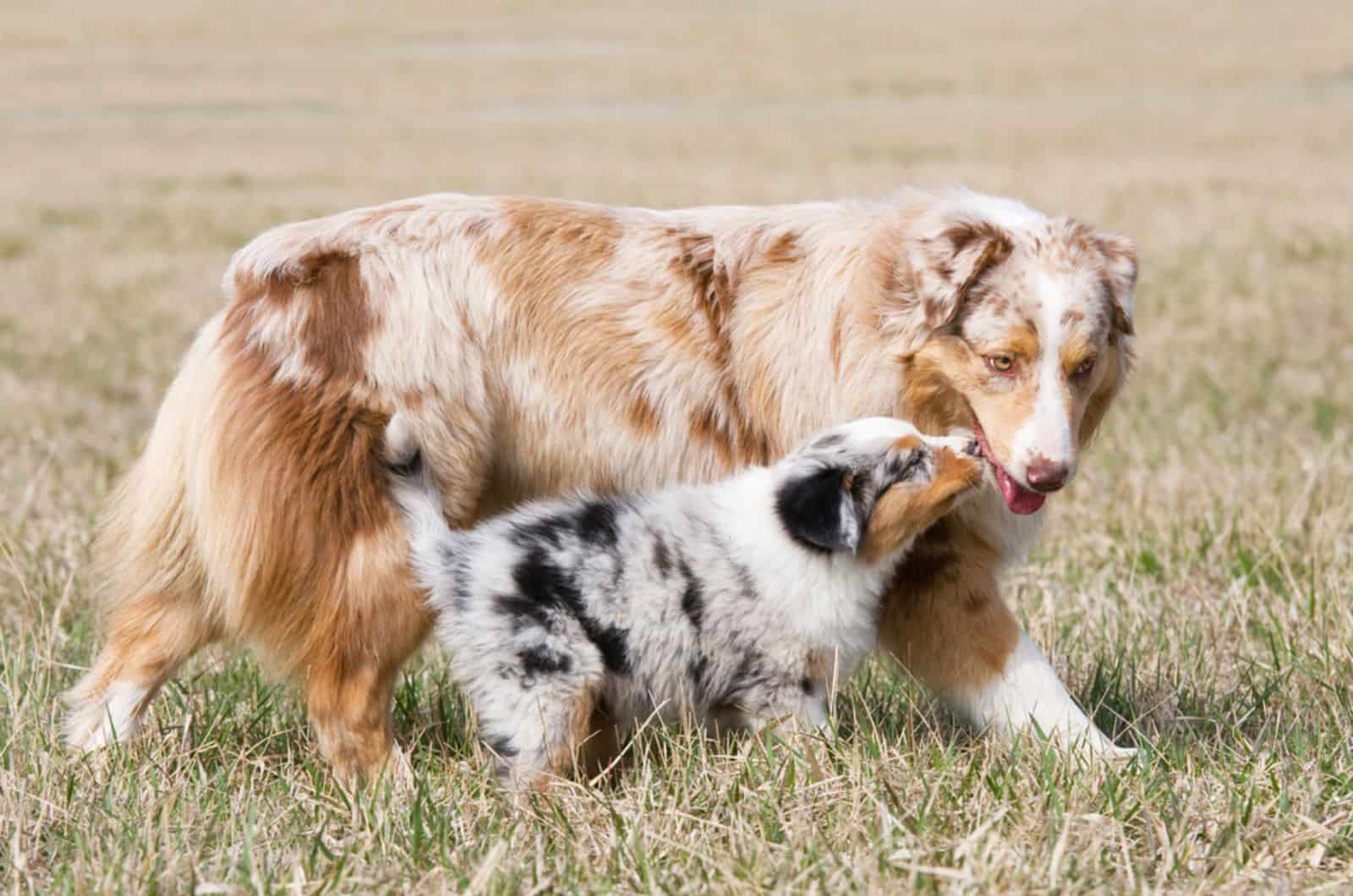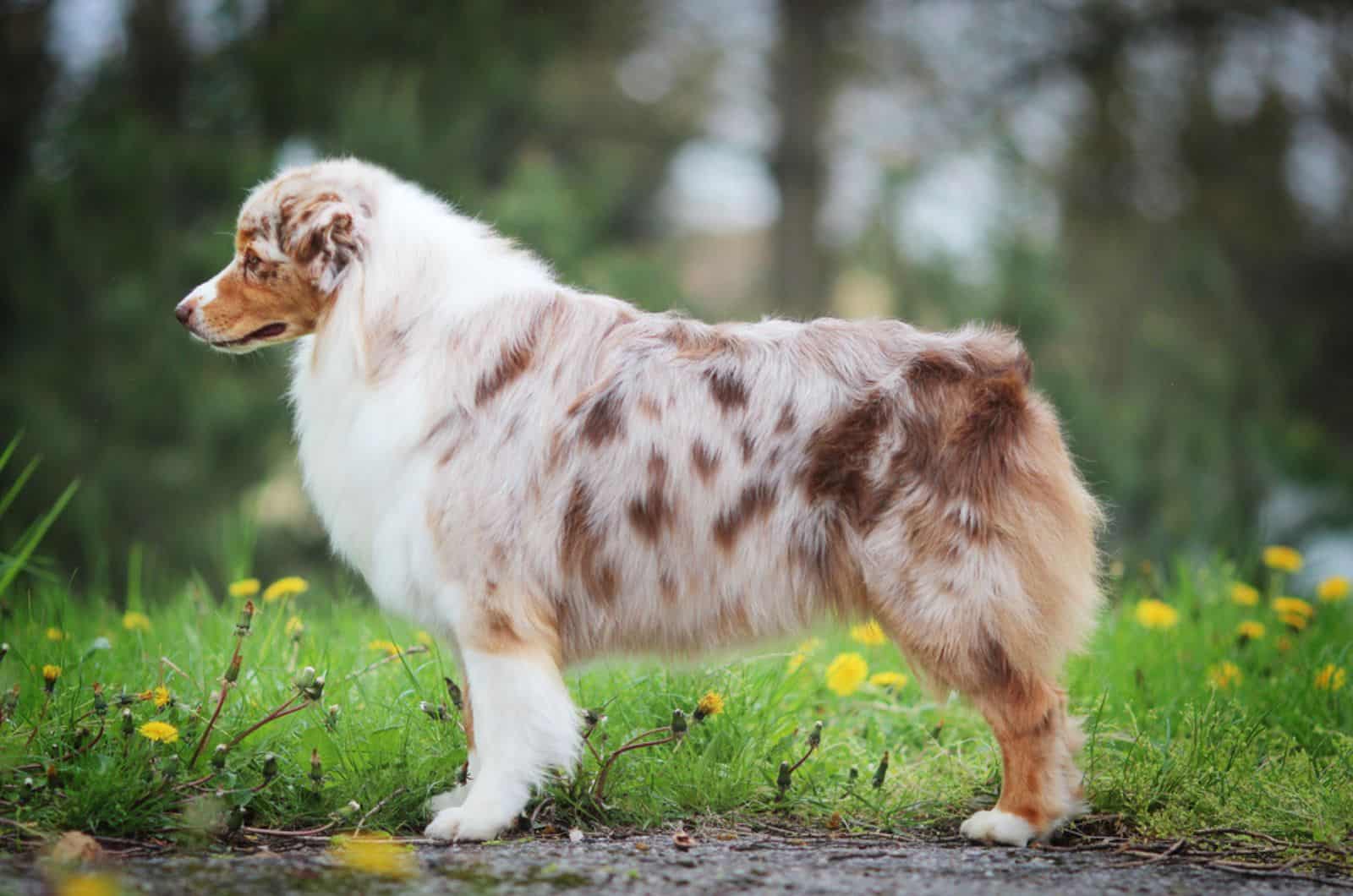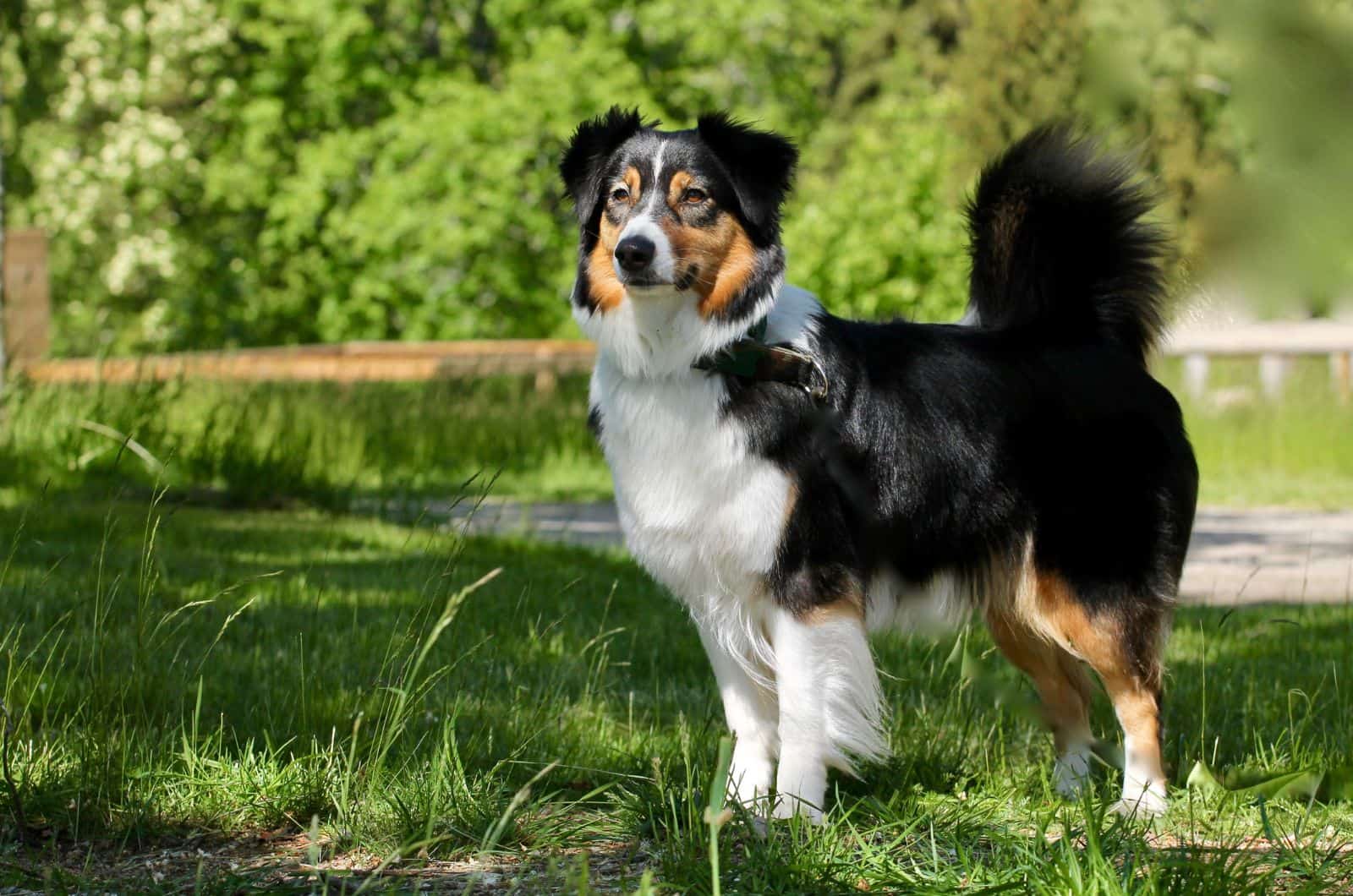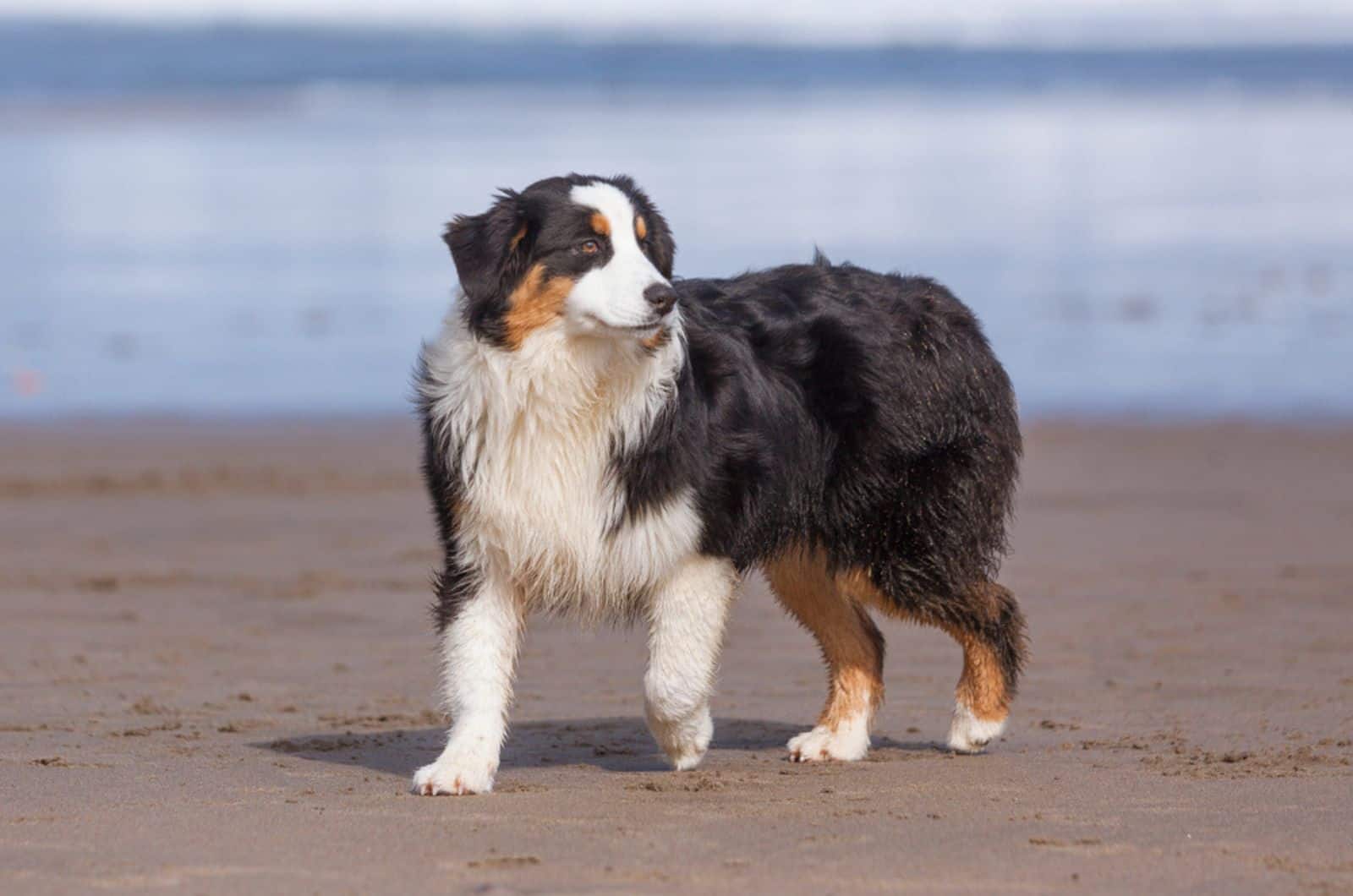Aren’t they cute when they wiggle their whole body when they are happy or excited? Australian Shepherd dogs are beautiful and smart pooches that have been helping people around the world gather their flock for a long time.
They have a unique coat color, especially if it’s merle, gorgeous blue eyes, and a fluffy tail. Wait? Do Australian Shepherds have tails?
If I asked you to picture an Australian Shepherd dog right now, what would you picture in your head? A dog with or without a tail? If some of you pictured an Australian Shepherd with a tail and some of you without it — don’t worry. It’s not one of those Mandela effects.
You are all correct. The Australian Shepherd’s tail can be long or docked — our “no-tail” version. How is that possible?
Well, we will talk about it in detail later, but in general, sometimes a man is responsible for two Aussie’s tail versions, and sometimes it’s genetics.
Let’s unravel the Australian Shepherd tail mystery.
The Australian Shepherd Tail

This is a medium-sized dog breed that can come in various coat color patterns. But it’s not just the looks that made us fall in love with this wonderful dog — it is their personality too.
The American Shepherd dog is an intelligent, high-energy dog that will loyally stand by your side. They have beautiful blue, amber, or multicolored eyes that made Native Americans call them ghost-eye dogs.
But, what about the Australian Shepherd‘s tail? All dogs have tails, so this breed has to have them too. But is the tail naturally short, or do we dock the tail? Can an Australian Shepherd dog be born with a long tail?
Mystery solved — they can have all three versions of a tail. Most working Australian Shepherd dogs have a docked tail because a long tail might get in the way while they work. The truth is, you don’t have to dock your Aussie’s tail if you don’t want to.
If you don’t own a flock of sheep or you don’t need your Australian Shepherd to do some work, you can keep the tail long. But, sometimes, a long tail of an Australian Shepherd can lead to health issues. That’s when we have to shorten the tail.
Now, let’s take a deeper look at these three versions of the Australian Shepherd tail. Hopefully, it will help you decide what kind of tail you want for your Aussie.
1. Docked Tail

First of all, let’s see what “docking a tail” means.
Tail docking is a surgical procedure done by a professional (a DVM – Doctor of Veterinary Medicine) in a vet clinic. It involves removing the distal part of a dog’s tail and leaving a stump or so-called docked tail or a bobtail.
Tail bobbing and tail docking are terms used to describe the surgical procedure of tail shortening. This procedure should be done when the puppies are a few days old.
The procedure is done at such an early age because of the undeveloped spinal cord of a puppy. When a puppy is born, they don’t have a fully developed nervous system.
An undeveloped nervous system means the puppies do not feel pain during the docking procedure. They don’t feel pain because the nerves in the puppy’s tail are not fully developed. Simply put, there is nothing to send a pain signal back to the brain. No signal — no pain.
Tail docking can be performed for cosmetic reasons, or if you are looking for a working dog — practical reasons. We will talk about the reasons as well as the pros and cons later in the text.
The docked-tailed Aussie is the most common version of the Australian Shepherd tail. Most people will think about this type of Aussie dog when they think about this dog breed.
The American Kennel Club (AKC) only recognizes Australian Shepherd tails that are not longer than four inches. It can be naturally bobbed or docked, but it cannot be longer than 4 inches (10cm).
Of course, these are Show dog standards and they have no other but cosmetic purposes. When it comes to a shortened tail, it is all subjective. As long as your dog is not going to spend its days running around chasing sheep, it will be fine with a full-length tail, too.
Of course, a long tail is a good choice only if it’s a healthy tail without any issues that can endanger the Australian Shepherd’s health.
2. Natural Bobtail

Australian Shepherd dogs can have a bobtail or a short tail from birth. For every Australian Shepherd dog litter, there is a 20% chance that one of them will be a bobtailed Australian Shepherd puppy.
The reason for this naturally short tail length is the mutation present in the T gene (C189G). The mutation happens during the transcription of the genes, and the result is an incomplete dominant gene which leads to a tailless dog.
This is a mutation that happens in Pembroke Welsh Corgis the most. The Australian Shepherd Health and Genetics Institute (ASHGI) has come to the conclusion that one in five Aussie dog puppies can be born with a short tail, as well.
The incomplete dominant gene is also responsible for the merle coat color in Aussie dogs.
The length of a naturally bobbed tail varies from dog to dog. It can be just a stub, barely seen under the fluffy fur of the Aussie dog or it can be half the normal length. But it is not just the length that can vary.
Health Problems
If the genetic mutation happens, there are chances that the dog will have some form of kinked tail, Spina Bifida, hindquarters paralysis, or some other type of lower spinal cord defect.
A kinked tail looks like a crooked tail and it is not a health-threatening deformity. Depending on the mutation, it can be mildly or severely crooked.
Spina Bifida has serious consequences. It happens in the uterus during the forming of the spinal cord of the puppy. The spinal vertebrae don’t properly close leaving a gap and exposing the spinal cord. This can cause various health problems.
A dog with Spina Bifida can have problems walking or could not be able to walk at all. They can also have problems with controlling the bladder sphincter, which means they will have a urine incontinence problem.
Besides urine, they can have fecal incontinence, too. This, on the other hand, leads to skin irritation issues, secondary infections, etc.
Breeding Issues
There is yet another problem with a bobtailed Aussie. Breeders shouldn’t breed two dogs that have a T gene mutation. Simply put, breeding two naturally bobtailed Australian Shepherd dogs is dangerous. Why? Because of the health issues that could result in the death of the puppies.
The “Bobtail gene” is a recessive gene that can be present in all Australian Shepherd dogs. That means that a healthy Aussie that was born with a normal-length tail can produce offspring in which one of the puppies has a naturally bobbed tail (NBT).
But breeding two Australian Shepherd dogs with the gene mutation will likely result in having a puppy with severe deformities that cannot be treated. The only humane solution is the euthanasia of such puppies.
3. Long Tail

Australian Shepherd puppies are born with long tails. But, because of the American Kennel Club breed standards, this type of Aussie dog is rarely seen.
This type of tail — a long tail, is a normal physical characteristic of this dog breed. Of course, as we’ve already mentioned, a mutation can happen, resulting in a shortened tail. But it is a mutation — not a normal occurrence. It’s not a normal tail.
So, if we don’t intervene with nature and leave everything as it is, the Australian Shepherd’s tail will be long. The American Veterinary Medical Association (AVMA) is strongly against tail-docking for cosmetic reasons or in order to fulfill Dog show standards.
The AVMA is against it because they approve medical procedures on dogs only if they are needed for medical reasons. They believe that docking the tail of a family dog that has nothing to do with herding or working on a farm, is unnecessary. It is similar to ear cropping procedures done on some dog breeds, e.g., Great Dane ear cropping.
Green Light
In certain situations, cropping a long tail can be approved. Most of the stations that give the green light to cropping an Australian Shepherd tail are work-related.
If a dog does the job it was originally bred for, herding flocks of sheep, some tail injuries can occur. We will talk in detail about how and why these injuries happen.
But it must be noted that tail docking is also approved if a dog owner notices that the dog has cleaning problems due to the fur mats and tangles. These mats and tangles make proper cleaning impossible, which can lead to skin irritation or bacterial and fungal infections.
What Are The Reasons For The Australian Shepherd Tail Docking?

This dog breed has the word Shepherd in its name for a reason. They were originally bred to help people with sheep herding. They are used as shepherd dogs even today, and they are one of the best at what they do.
Herding a flock is a serious task for a dog. They have to constantly be on alert for where the sheep go, run after them, jump on them, whatever it takes to keep them in line.
But, working on a farm, keeping the flock in order, and running on various terrain can lead to injuries. The most fragile and unprotected part of a working Aussie dog is its tail. That is the part of the Aussie dog’s body that gets hurt easily.
An injured tail is not only painful for the dog, but it can lead to secondary infections and further health complications. Simply put, you can put your dog’s life in danger if you leave the tail undocked.
Medical Benefits Of A Docked Australian Shepherd Tail
Even though the AVMA is against tail docking for cosmetic reasons, they are not against docking the Australian Shepherd’s tail for medical reasons. We can divide all medical reasons for tail docking into three groups.
1. Prevents Work Injuries
As we’ve mentioned, a long tail can pose a threat to a working Australian Shepherd dog. A long tail can easily get caught in the bushes. No matter how clever Aussie dogs are, they don’t know how to untangle themselves safely from the branches or the shrubs.
So, the outcome is a dislocated dog’s tail or a dog yelping and whining because it can’t move. This happens because of the type of fur an Australian Shepherd dog has.
They have a double, medium-length coat. This type of coat can easily get tangled, matted, and stuck in the bushes while the dog is working.
2. Prevents Sanitation Issues
This reason seems like it’s not that important, but when you look at the greater picture, you see that sanitation plays a big role in your dog’s health.
If you have a dog that has a fluffy, medium-length, and double coat — cleaning can be a problem. Keeping hygiene high is an issue every time a dog defecates or urinates. The high possibility of mats and tangles doesn’t help either.
If fecal matter gets stuck in the matted fur it can become a big nuisance for both the dog and the owner. Not to mention that, if not cleaned, it can lead to bacterial and yeast infections.
3. Prevents Splitting
Most of the natural Australian Shepherd’s tails are long and of good bone structure, without any locus minoris resistentiae — without parts of it that are more vulnerable.
But sometimes this dog breed can have a brittle last third of the tail. The brittle part is the mentioned locus minoris resistentiae, and it leads to injuries, such as splitting or breaking. Obviously, such injuries are body traumas, and they are very painful.
If the Australian Shepherd has a fragile last third of the tail, docking it is a humane thing to do. Not only humane but medically approved, as well.
How Do They Dock The Tail?

Whatever the reason for tail docking is, there are two ways to do it. Both are supposed to be done by a licensed veterinarian when a puppy is a few days old. There is a quick way to dock the tail and another one that takes more time to complete the procedure.
Both ways are not done under general anesthesia. Cutting a part of a body without anesthesia might sound terrible, but there are medical reasons behind it:
- Puppies do not feel the pain (the nervous system is not yet developed)
- General anesthesia can lead to serious health complications in puppies
Now, you might wonder why not wait for the puppies to grow and dock the tail under general anesthesia. The answer is — we love our doggos.
The whole procedure, from going to the vet to waking up and feeling post-anesthetic confusion, is a traumatic experience for a dog.
And there is the post-operational pain a dog will feel. They will want to lick or even bite the post-operational wound or sutures, and that can lead to incision healing problems, similar to spay incision healing issues in a dog.
So, this procedure should be done a few days after the birth of the puppies, and there are two ways to do it.
1. Quick Procedure
This is the first option, and it lasts around 10 minutes. It can be done even faster – up to 5 minutes if it is done by an experienced professional.
A reminder, it should always be done by a professional, no questions asked. If you want to dock the tail of your dog, you should never do it on your own!
How it’s done:
- A puppy is a few days old
- The vet uses surgical scissors (or a surgical knife)
- A cut is made between the first and the second vertebra of the tail
- Bleeding is stopped by cauterization
Cauterization or cautery is a procedure done to stop the bleeding from the wound. It can be chemical cautery or thermal (electro) cautery.
Quick tail docking is a common and safe medical procedure. But you have to remember that it is permanent. So, think about it. Do you want your dog to fit into AKC Show conformation standards or do you just want a happy Australian Shepherd, with or without a tail?
2. Longer Procedure
The second option is called a long procedure. For this procedure as well, the Australian Shepherd puppies should be a few days old (up to 10 days). Once again, puppies do not have a developed nervous system when they are born, so they do not feel pain during or after the tail-docking procedure.
Just like the first procedure — the quick one, this tail-docking procedure should always be done by a licensed veterinarian. Doing the longer procedure on your own can lead to serious and traumatic health issues! Do not do it on your own.
How it’s done:
- A puppy is a few days old
- A rubber tail band is placed between the first and the second tail vertebrae
- The circulation to the distal parts of the tail is cut off by this tail band
- The body will naturally reject the part of the tail that has no blood supply
- The tail falls off after 8 to 10 days
As you can see, this is a bloodless procedure. It is also less traumatic for the puppy’s body. But it can have more complications if not done properly. If the rubber tail band is not placed correctly or in the correct place, it can lead to deformities, infection, or pain.
Using a rubber tail band to dock the Australian Shepherd’s tail is a serious procedure. It sounds simple and like anyone can do it, but it is most certainly not!
The Conclusion
The mystery of the Australian Shepherd’s tail is solved. This dog breed has a tail, and it can come in three variants:
- Naturally long
- Naturally bobbed
- Docked
We’ve shown you the pros and cons of tail docking, and it is up to you to decide what you want for your dog. If you are looking for a working dog, tail docking is a good option. It will prevent your dog from having injuries while it works.
If you are looking for a Show dog that will win the hearts of the Dog Show judges, tail docking is the answer. The AKC recognizes the Australian Shepherd dog that has a tail no longer than 4 inches.
If you are looking for a family pet and a new furry best friend, you don’t have to dock the tail. The essence of the Australian Shepherd’s amazing nature is not located in its short tail. An Aussie will be just as loyal, energetic, and intelligent with a long tail as it would with a short one.
But, if your vet recommends docking for medical reasons, of course, we should listen to the professional and dock the tail.
Whatever you choose, remember that your dog’s health comes first.















